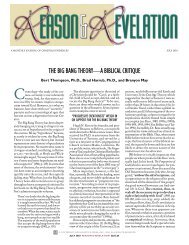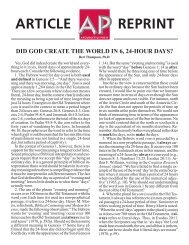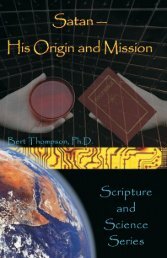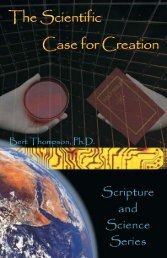The Many Faces, and Causes, of Unbelief - Apologetics Press
The Many Faces, and Causes, of Unbelief - Apologetics Press
The Many Faces, and Causes, of Unbelief - Apologetics Press
You also want an ePaper? Increase the reach of your titles
YUMPU automatically turns print PDFs into web optimized ePapers that Google loves.
[t]here is activity but no Actor, movement but no<br />
Mover, creation but no Creator. Beginning with an<br />
anthropomorphic bipolar model <strong>of</strong> God, it is no wonder<br />
that the god <strong>of</strong> panentheism emerges finite, limited<br />
in knowledge, goodness, <strong>and</strong> power, <strong>and</strong> in possession<br />
<strong>of</strong> a physical body like the rest <strong>of</strong> us. Whatever<br />
else may be said <strong>of</strong> this whittling <strong>of</strong> God down to<br />
man’s level <strong>and</strong> form, it is surely not the God presented<br />
in the Bible (1976, p. 210).<br />
<strong>The</strong> God <strong>of</strong> panentheism most certainly is not the God <strong>of</strong><br />
the Bible. Do the Scriptures speak <strong>of</strong> God engaging in temporal,<br />
changing actions on occasion? Certainly. In fact, the Bible<br />
uses a number <strong>of</strong> different metaphors drawn from specific<br />
human analogies. For example, God is said to “repent”<br />
( Jonah 3:10), to have “arms” (Psalm 136:12), to see with “eyes”<br />
(Hebrews 4:13), <strong>and</strong> to hear with His “ear” (Isaiah 59:1-2).<br />
Yet the Bible also speaks <strong>of</strong> God as a “rock” (Psalm 18:2), a<br />
“tower” (Proverbs 18:10), <strong>and</strong> as having “wings” (Psalm 91:<br />
4). If one wishes to use these metaphors to frame a personal<br />
concept <strong>of</strong> God (as panentheists attempt to do), two things<br />
first must be acknowledged. (1) <strong>The</strong> Bible uses metaphorical/anthropomorphic<br />
terminology that is intended to assist<br />
humans (who are finite) as they grapple with the spiritual nature<br />
<strong>of</strong> God (Who is infinite). (2) At times, the images that are<br />
used are mutually conflicting (some speak <strong>of</strong> minerals [a rock],<br />
some speak <strong>of</strong> animal characteristics [wings], <strong>and</strong> some speak<br />
<strong>of</strong> human traits [arms, ears, eyes, etc.]. It is not a proper use <strong>of</strong><br />
Scripture to take these images <strong>and</strong> apply them in a literal fashion<br />
to make the Universe God’s body. Furthermore, such an<br />
attempt ignores additional passages <strong>of</strong> Scripture which teach<br />
that God, as a Spirit ( John 4:24), is both infinite (Psalm 147:5)<br />
<strong>and</strong> unchanging (Malachi 3:6; Hebrews 6:18; James 1:17).<br />
Panentheism has little to recommend it, <strong>and</strong> much to dissuade<br />
us from accepting it. <strong>The</strong> “god” <strong>of</strong> panentheism can<br />
“coax” us, but not comm<strong>and</strong> us. He can fight evil, but never<br />
triumph over it. He allegedly intends to achieve a better world<br />
with human cooperation, yet most <strong>of</strong> the world is happily<br />
oblivious to His existence. He is supposed to be able to achieve<br />
-56

















